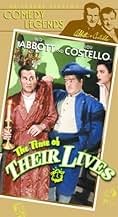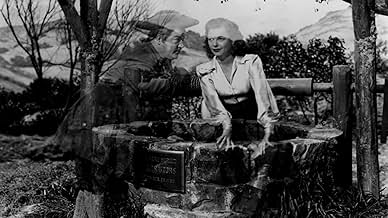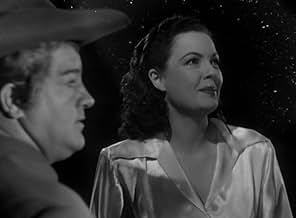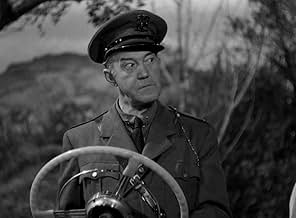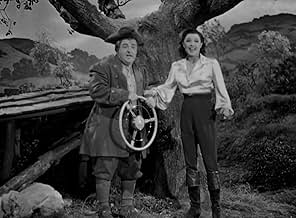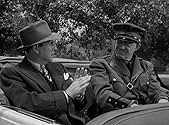NOTE IMDb
7,5/10
3,9 k
MA NOTE
Ajouter une intrigue dans votre langueA psychiatrist stays in a mansion haunted by prankish ghosts from the Revolutionary War.A psychiatrist stays in a mansion haunted by prankish ghosts from the Revolutionary War.A psychiatrist stays in a mansion haunted by prankish ghosts from the Revolutionary War.
- Réalisation
- Scénario
- Casting principal
Lynn Baggett
- June Prescott
- (as Lynne Baggett)
Ann Gillis
- Nora O'Leary
- (as Anne Gillis)
Robert Barrat
- Maj. Putnam
- (as Robert H. Barrat)
Kirk Alyn
- Dandy at Party
- (non crédité)
Harry Brown
- Second Sergeant
- (non crédité)
George M. Carleton
- Museum Guard
- (non crédité)
Wheaton Chambers
- Bill - Museum Guard
- (non crédité)
James Conaty
- Party Guest
- (non crédité)
Avis à la une
THE TIME OF THEIR LIVES (1946) ***1/2 Abbott and Costello original with the team "separated": Lou's a Revolutionary War-era ghost with comely spirit Marjorie Reynolds who both were murdered and branded traitors to America, and due to a curse set upon their souls are forced to remain on Earth until they are proven patriots thanks to a letter in an antique clock authored by George Washington. Bud is very good as an ancestor of Costello's arch nemesis providing Lou a good reason to scare him. Pretty funny and some solid acting from the duo.
This enjoyable and rather creative Abbott and Costello feature gives Bud and Lou each a chance to do a lot more on their own, while telling an entertaining story at a good pace. It's different from most of their films, in that Bud and Lou have very few moments when their characters interact. It works quite well, though, and it is certainly among their better movies.
The story takes a little while to set up, but then it begins to move more quickly. Once the prologue is over and the main plot begins, Costello and Marjorie Reynolds are quite entertaining as the two ghosts. There is just enough explanation provided to make the plot work, without going overboard or taking the premise too seriously.
The lengthy sequence with Bud and his friends trying to communicate with Costello and Reynolds provides many of the movie's best moments, and there is plenty of good material in the rest of the film as well. This picture delivers just what you hope for in a light comedy.
The story takes a little while to set up, but then it begins to move more quickly. Once the prologue is over and the main plot begins, Costello and Marjorie Reynolds are quite entertaining as the two ghosts. There is just enough explanation provided to make the plot work, without going overboard or taking the premise too seriously.
The lengthy sequence with Bud and his friends trying to communicate with Costello and Reynolds provides many of the movie's best moments, and there is plenty of good material in the rest of the film as well. This picture delivers just what you hope for in a light comedy.
Following the disappointing returns of "Little Giant," Universal decided to continue the experiment of using Abbott and Costello as separate characters in a film -- but with a few changes. The pathos of "Little Giant" was dropped, and the focus returned to comedy. A stronger plot was created, and the movie was set in part in the 18th century. The end result was "The Time of Their Lives," which must rank high among the best of A&C's films.
Perhaps one reason A&C's characters were not a team again in this film was a feud between Abbott and Costello, but no one is quite sure. The reason was probably due to wanting to try something different. With "Little Giant," this effort failed; with "TOTL," they succeeded because Abbott fits so naturally into both his characters and because the storyline is fresh and different.
The tried-and-true A&C routines are missing, but no one notices because much of the humor derives from situations, which are often funny. The reactions to Costello's hauntings are hilarious, and Bud gets some very genuine laughs. I agree with everyone that if A&C had broken up at this time, Abbott would have made a fine character actor in comedies, in a Eugene Pallette sort of way (though without Pallette's girth.)
Despite the reputation this film enjoys today, 1946 audiences seemed rather tepid towards another A&C situational comedy with the boys not appearing as a team. As a result, this type of film was never again tried by A&C. However, it is a film worthy of viewing and deserves the reputation it enjoys today as one of their finest. 8 out of 10.
Perhaps one reason A&C's characters were not a team again in this film was a feud between Abbott and Costello, but no one is quite sure. The reason was probably due to wanting to try something different. With "Little Giant," this effort failed; with "TOTL," they succeeded because Abbott fits so naturally into both his characters and because the storyline is fresh and different.
The tried-and-true A&C routines are missing, but no one notices because much of the humor derives from situations, which are often funny. The reactions to Costello's hauntings are hilarious, and Bud gets some very genuine laughs. I agree with everyone that if A&C had broken up at this time, Abbott would have made a fine character actor in comedies, in a Eugene Pallette sort of way (though without Pallette's girth.)
Despite the reputation this film enjoys today, 1946 audiences seemed rather tepid towards another A&C situational comedy with the boys not appearing as a team. As a result, this type of film was never again tried by A&C. However, it is a film worthy of viewing and deserves the reputation it enjoys today as one of their finest. 8 out of 10.
Most fans of Abbott & Costello, if they don't consider THE TIME OF THEIR LIVES the best film they made consider it among the best films they made. It is an unusual film - their is some interplay between the two in the 18th Century sequences, where Abbott's Cuthbert plays his normal bossy and unscrupulous acquaintance to Costello's patriotic Horatio. To add to their normal problems with each other, they both like the same servant girl. Horatio has one prized possession - a letter from George Washington praising his patriotism. Unfortunately, the servant girl's employer is a large landowner who is a traitor (and a member of Benedict Arnold's conspiracy). The landowner has a girlfriend named Melonie, played by Marjorie Reynolds (probably her best remembered role after Bing Crosby's girlfriend in HOLIDAY INN). Melonie is momentarily in control of the letter, but her boyfriend takes it and hides it inside an expensive clock. Then the patriots arrive - Major Andre has been captured and the conspiracy revealed. Everyone flees, but Costello and Reynolds are shot and killed before they get away. A curse is put over their remains in their grave on the estate that (mistakenly considered) traitors they are doomed to be forever at unrest there.
The ghosts of the two find they literally are stuck their (the special affects are good - they accidentally run through each other and find they are wearing each other's clothing). They see a sign that reveals the curse that was unfairly put on them. Both know if the letter is found they would be released. But time passes. They don't know where the note is, or how to get to it.
Comes the 20th Century and Binnie Barnes, Abbott, and John Shelton show up - Abbott a descendant of the 18th Century scoundrel. They are planning to turn the old estate into an inn. Costello, with two centuries of bile and anger building up in him, torments Abbott (in this film Costello maintains the whip hand for a change). Gradually, with the aid of medium Gale Sondergaard, they learn what happened. And Abbott decides to redeem his family name by freeing the ghosts.
It is surprising that the Arnold Conspiracy is the only incident of the American Revolution that seems to have been properly handled in the movies, both here and in the later THE SCARLET COAT. But that was a more in depth look at the tragedy and heroism of Major John Andre. Here the Arnold conspiracy, while the motor for the plot, is only shown in the first twenty minutes of the film (then it goes modern), and the film (for all the tragedy for Costello and Reynolds in their rightful lifetimes) is mostly comic. The antics of the pair, in particular Costello's campaign against the hapless modern Abbott, is funny - living up to the first part of the pun of the title. For all their anguish at being cursed unfairly, the two ghosts get to enjoy themselves - they do have the time of their lives. The other half of the pun, of course, deals with the key to their salvation: that all important letter - hidden inside an 18th Century timepiece.
The ghosts of the two find they literally are stuck their (the special affects are good - they accidentally run through each other and find they are wearing each other's clothing). They see a sign that reveals the curse that was unfairly put on them. Both know if the letter is found they would be released. But time passes. They don't know where the note is, or how to get to it.
Comes the 20th Century and Binnie Barnes, Abbott, and John Shelton show up - Abbott a descendant of the 18th Century scoundrel. They are planning to turn the old estate into an inn. Costello, with two centuries of bile and anger building up in him, torments Abbott (in this film Costello maintains the whip hand for a change). Gradually, with the aid of medium Gale Sondergaard, they learn what happened. And Abbott decides to redeem his family name by freeing the ghosts.
It is surprising that the Arnold Conspiracy is the only incident of the American Revolution that seems to have been properly handled in the movies, both here and in the later THE SCARLET COAT. But that was a more in depth look at the tragedy and heroism of Major John Andre. Here the Arnold conspiracy, while the motor for the plot, is only shown in the first twenty minutes of the film (then it goes modern), and the film (for all the tragedy for Costello and Reynolds in their rightful lifetimes) is mostly comic. The antics of the pair, in particular Costello's campaign against the hapless modern Abbott, is funny - living up to the first part of the pun of the title. For all their anguish at being cursed unfairly, the two ghosts get to enjoy themselves - they do have the time of their lives. The other half of the pun, of course, deals with the key to their salvation: that all important letter - hidden inside an 18th Century timepiece.
Coming after LITTLE GIANT, a film in which Abbott and Costello were NOT a pair and in which Bud Abbott played a dual role, here is the second film that experimented with the A&C format. The film is set in the Revolutionary War period and then in 1946, with Costello playing the same role in both parts, and Abbott playing different roles (although the characters are related, just spread over 170 years!). There are a lot of funny sequences, but the historical angle makes the rest of the film very interesting in its own right. With appearances by such b-movie stalwarts as Kirk Alyn and Rex Lease, a fine supporting cast, and good-looking historical settings,the film is handsome looking and holds up well today. THE TIME OF THEIR LIVES is a nice change-of-pace for the Abbott and Costello fan, and once again shows that Costello was capable of carrying an entire feature film himself--and that Bud Abbott was excellent in character roles, not just as half of a comedy team. Newly reissued on DVD, the film should find an appreciative new audience.
Le saviez-vous
- AnecdotesWriting in the "Saturday Evening Post" in 1949, Bud Abbott said this was his favorite film role, because for a change he was the butt of all the punishment, instead of Lou Costello.
- GaffesIn the prologue, set in 1780, Horatio Prim (Lou Costello) uses the term "teetotaler" to say he doesn't drink alcohol. The term (short for "total temperance") didn't exist until the late 19th century.
- Citations
Mildred Dean: [to Emily] Pardon me, but did I see you in "Rebecca?"
- ConnexionsFeatured in Svengoolie: The Time of Their Lives (2016)
- Bandes originalesMinuet
(uncredited)
from "String Quintet in E Major, Op.13 No.5"
Written by Luigi Boccherini
Played as dance music at the party
Also played on a harpsichord and as background music
Meilleurs choix
Connectez-vous pour évaluer et suivre la liste de favoris afin de recevoir des recommandations personnalisées
- How long is The Time of Their Lives?Alimenté par Alexa
- What nonsense phrase did Horatio Prim always mutter when disappointed?
Détails
- Date de sortie
- Pays d’origine
- Langue
- Aussi connu sous le nom de
- The Time of Their Lives
- Lieux de tournage
- Société de production
- Voir plus de crédits d'entreprise sur IMDbPro
Box-office
- Budget
- 830 000 $US (estimé)
- Durée1 heure 22 minutes
- Couleur
- Rapport de forme
- 1.37 : 1
Contribuer à cette page
Suggérer une modification ou ajouter du contenu manquant

Lacune principale
By what name was Deux nigauds dans le manoir hanté (1946) officially released in India in English?
Répondre

